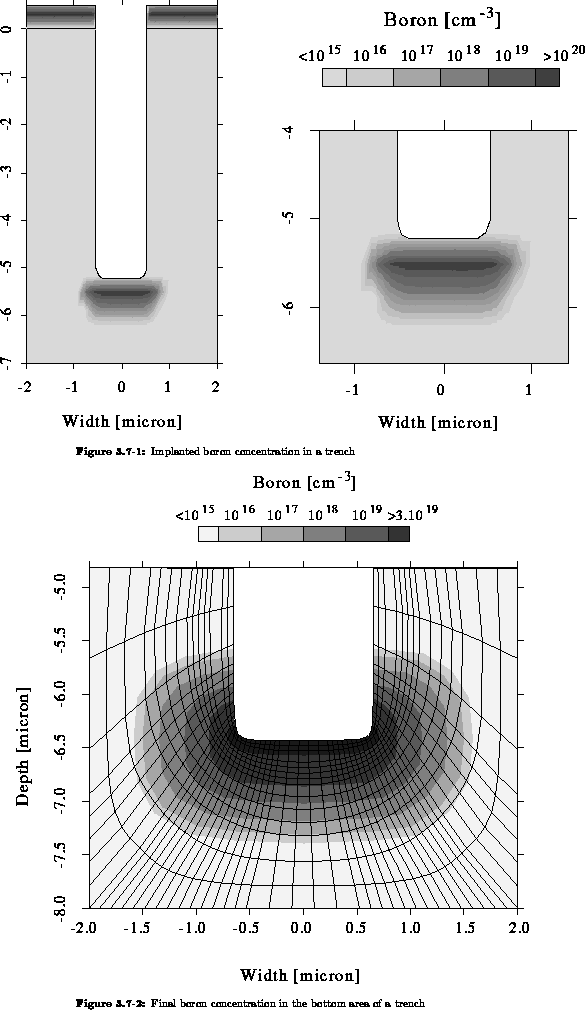3.7.1 Trench Isolation




Next: 3.7.2 LDD P-Channel Transistor
Up: 3.7 Applications
Previous: 3.7 Applications
Trench isolation is a common technique for lateral separation of the
n-channel transistor's p-tub (also called p-well) from the p-channel
transistor's n-tub in a CMOS twin-tub process and therefore to isolate the
two different types of transistors [Hil88b], or for isolating the
bipolar transistor from the MOS-transistor in BiCMOS technology
[Liu92].
In the example to be discussed, a layer of  was deposited and
used as an etch mask during reactive ion etching of silicon. The etch
process was simulated performing a SAMPLE [Add91] anisotropic
plasma assisted etch and a subsequent isotropic etch step. After trench
formation we implanted
was deposited and
used as an etch mask during reactive ion etching of silicon. The etch
process was simulated performing a SAMPLE [Add91] anisotropic
plasma assisted etch and a subsequent isotropic etch step. After trench
formation we implanted  boron with an energy of
boron with an energy of  .
For the simulation of the implantation step we used the analytical ion
implantation module of
PROMIS as described in Chapter 2. The trench
geometry and the implanted boron profile are shown in
Figure 3.7-1.
.
For the simulation of the implantation step we used the analytical ion
implantation module of
PROMIS as described in Chapter 2. The trench
geometry and the implanted boron profile are shown in
Figure 3.7-1.
Then, a sidewall oxide is grown to form an insulating layer, the trench is
filled with polysilicon, an oxide is grown to cap the trench and finally the
 is removed. Thereafter the standard CMOS process is proceeded.
The total thermal budget of the process steps after implantation is
approximated by
is removed. Thereafter the standard CMOS process is proceeded.
The total thermal budget of the process steps after implantation is
approximated by  at
at  plus
plus  at
at  . We
simulated the effect of the thermal treatment using the diffusion
model DIFN, neglecting the growth of the oxide. The final boron
profile at the trench's bottom region is shown in
Figure 3.7-2.
. We
simulated the effect of the thermal treatment using the diffusion
model DIFN, neglecting the growth of the oxide. The final boron
profile at the trench's bottom region is shown in
Figure 3.7-2.
Since only boron but no other dopants are present in the bottom area of the
trench (the adjacent n-well does not extend beyond 3 to 4 microns depth) the
application of the uncoupled model DIFN is sufficient. Note, that
the diffusion front is almost parallel to the grid lines of the curvilinear
grid. This means that grid refinement by inserting grid lines parallel to
the trench's inner surface is particularly efficient.





Next: 3.7.2 LDD P-Channel Transistor
Up: 3.7 Applications
Previous: 3.7 Applications
Martin Stiftinger
Wed Oct 19 13:03:34 MET 1994
 was deposited and
used as an etch mask during reactive ion etching of silicon. The etch
process was simulated performing a SAMPLE [Add91] anisotropic
plasma assisted etch and a subsequent isotropic etch step. After trench
formation we implanted
was deposited and
used as an etch mask during reactive ion etching of silicon. The etch
process was simulated performing a SAMPLE [Add91] anisotropic
plasma assisted etch and a subsequent isotropic etch step. After trench
formation we implanted  boron with an energy of
boron with an energy of  .
For the simulation of the implantation step we used the analytical ion
implantation module of
PROMIS as described in Chapter 2. The trench
geometry and the implanted boron profile are shown in
Figure 3.7-1.
.
For the simulation of the implantation step we used the analytical ion
implantation module of
PROMIS as described in Chapter 2. The trench
geometry and the implanted boron profile are shown in
Figure 3.7-1.




 at
at  plus
plus  at
at  . We
simulated the effect of the thermal treatment using the diffusion
model DIFN, neglecting the growth of the oxide. The final boron
profile at the trench's bottom region is shown in
Figure
. We
simulated the effect of the thermal treatment using the diffusion
model DIFN, neglecting the growth of the oxide. The final boron
profile at the trench's bottom region is shown in
Figure 